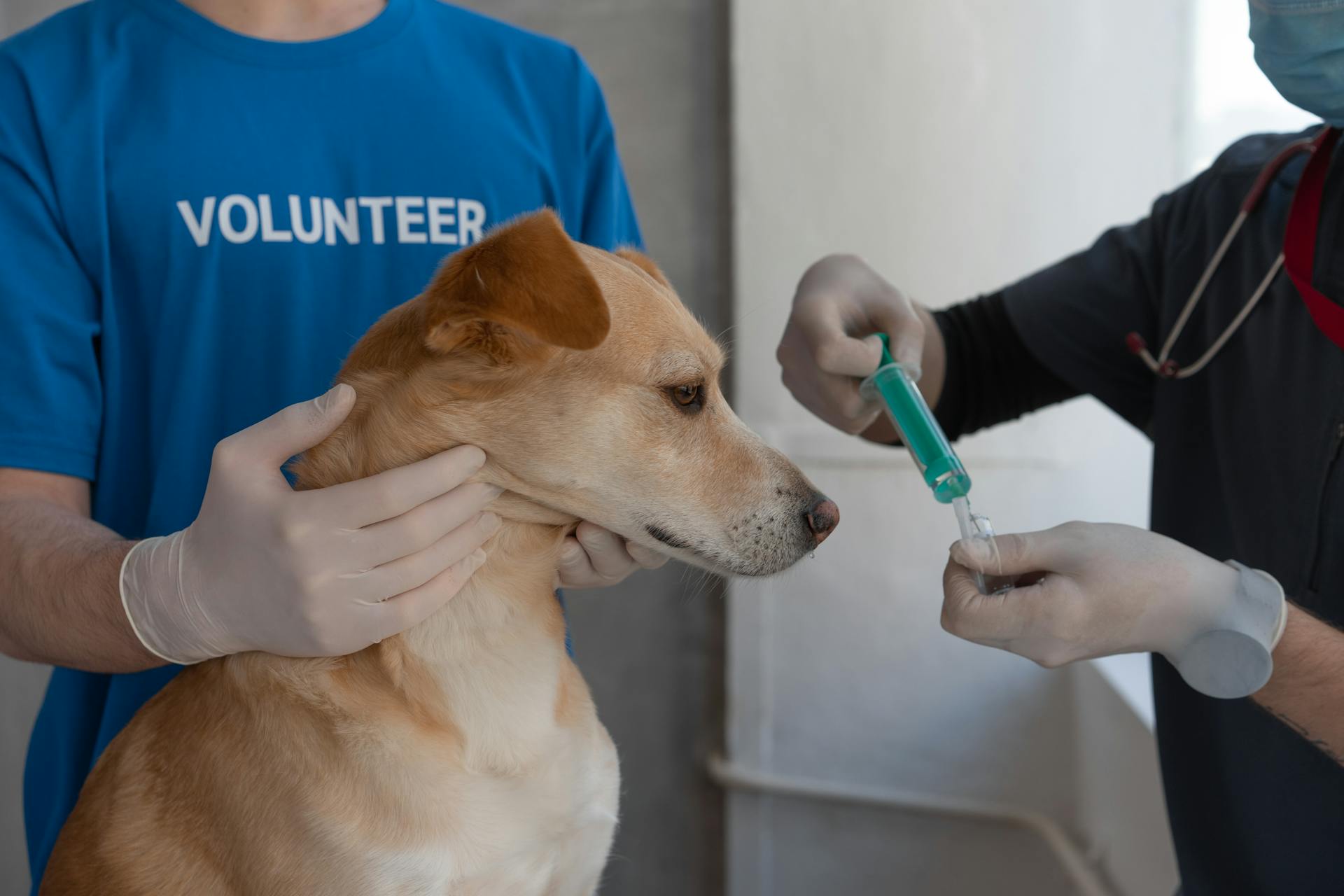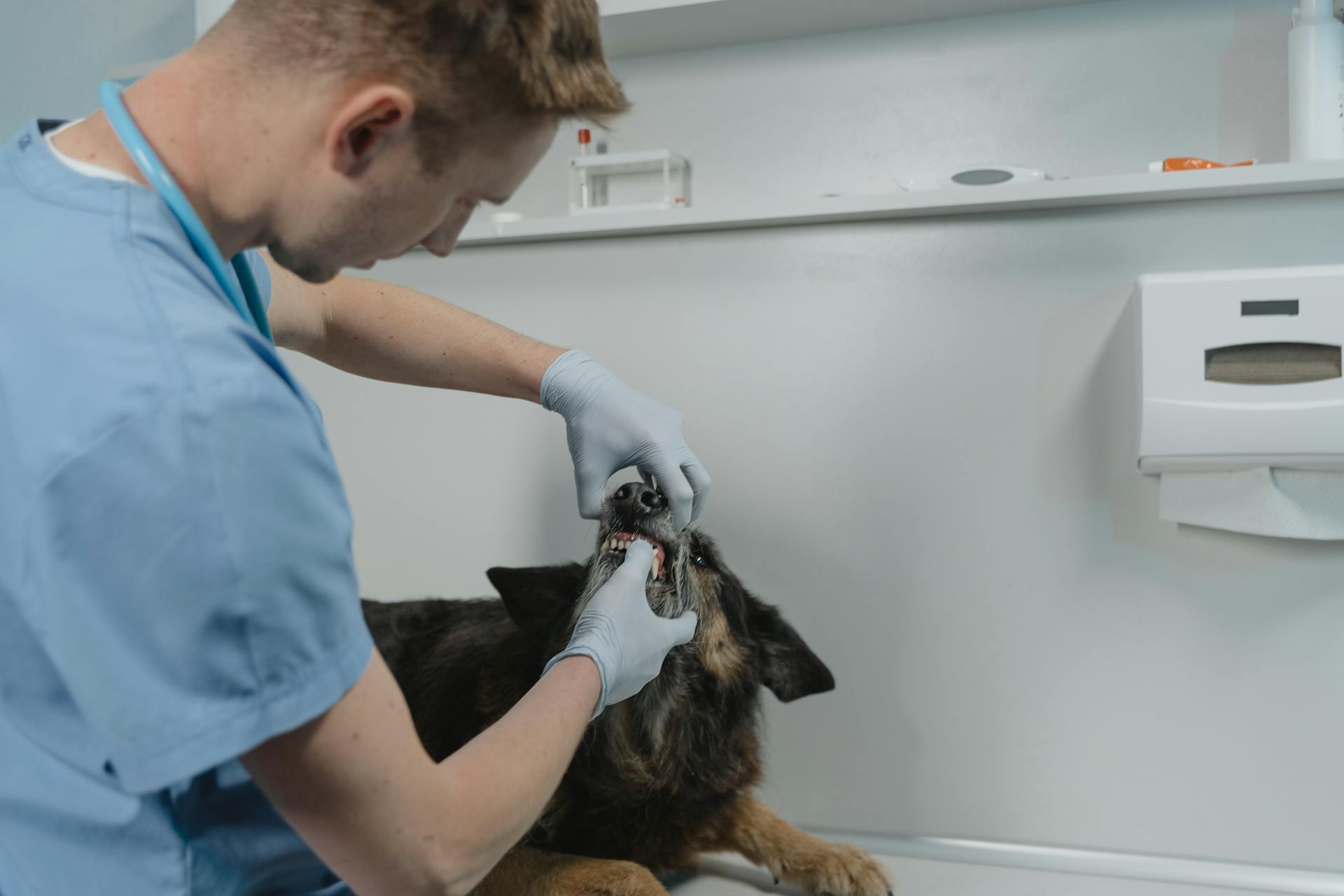
Dogs with canine spleen cancer often show non-specific symptoms, making diagnosis challenging.
Fatigue and lethargy are common signs of spleen cancer in dogs, as the disease can cause anemia and decreased red blood cell production.
A dog's appetite may decrease due to the disease's impact on its overall health and well-being.
Pet owners may notice their dog's abdomen becoming swollen or tender to the touch, which can be a sign of spleen cancer.
In some cases, dogs may experience vomiting or diarrhea, although these symptoms can be caused by other conditions as well.
Expand your knowledge: Canine Lupus
What Is Canine Spleen Cancer?
Canine spleen cancer, also known as hemangiosarcoma, is a type of cancer that affects the blood vessel walls. It's most often seen in breeds like German Shepherds, Golden Retrievers, Flat-Coated Retrievers, and Boxers.
This cancer can occur either inside the body cavity or on the surface of the skin. The skin variety can be easily removed surgically and carries an excellent chance of full recovery. Internal hemangiosarcoma is almost certainly fatal. Growths that form in the spleen, heart, or liver are difficult to detect until they become large enough to show symptoms.
Take a look at this: Canine Spleen Anatomy
Hemangiosarcoma is an aggressive cancer affecting the cells that make up blood vessels. The cancerous tissue forming these masses is not as strong as ordinary tissue and may rupture when filled with blood, causing sudden internal bleeding emergencies and potentially death.
The spleen is the most common spot where hemangiosarcoma is found, occurring about 50 percent of the time. The cancer can appear anywhere in the body since it's laced with blood vessels.
Symptoms and Signs
Symptoms of canine spleen cancer can be quite subtle at first, but as the disease progresses, they become more pronounced. A dark red or purple bump on the skin is a common sign, which may bruise or bleed.
Dogs with internal tumors may exhibit early signs such as lethargy and pale gums. As the tumor grows, blood vessels supporting it begin to leak, resulting in blood loss into the abdomen.
Some common symptoms of canine spleen cancer include weight loss, decreased appetite, increased panting, weakness, cough, and a bulging belly. If your dog is suddenly weak and has a swollen or pendulous abdomen or pale gums, it may be caused by their spleen rupturing and hemorrhaging.
Here are some key symptoms to look out for:
- Lump(s) detectable in the abdomen
- Black or red mass in the skin
- Weakness
- Pale mucous membranes
- Weight loss
- Partial or complete loss of movement
- Seizures and/or intermittent collapsing
- General lack of energy, lameness, and/or lack of engagement
Cancer Signs and Symptoms

Cancer can be a scary and overwhelming topic, but knowing the signs and symptoms can help you catch it early. Here are some common signs and symptoms to look out for:
A lump or swelling under the skin can be a sign of cancer. This can be a dark red or purple bump that may bruise or bleed.
If your dog is lethargic or has pale gums, it may be a sign of internal bleeding due to a tumor. I've seen dogs that have been lethargic and pale, and it's always a good idea to have them checked by a vet.
Weight loss and decreased appetite are common symptoms of cancer. If your dog is losing weight or not eating as much as usual, it's a good idea to take them to the vet.
Some dogs may experience difficulty walking or have a strong odor due to a tumor. This can be painful and uncomfortable for your dog, so it's essential to get them checked out.
For your interest: Cgc Dog Training

Here are some common signs and symptoms of cancer in dogs:
- Swelling or lumps under the skin
- Sores that don't heal
- Strong odor
- Bleeding or discharge
- Unexplained weight loss
- Appetite loss
- Difficulty walking or pain when walking
- Lumps or pumps below the skin
- Challenges when swallowing or eating
- Disinterest in exercise, lethargy or depression
- Straining to go to the bathroom
- Coughing, or difficult or painful breathing
Keep in mind that these symptoms can also be caused by other health issues, so it's always best to consult with a veterinarian if you notice any changes in your dog's behavior or physical condition.
Lymphoma/Lymphosarcoma
Lymphoma/Lymphosarcoma is a very common type of cancer in dogs, with over 30 categories that can develop in their bodies. It's a cancer that stems from a type of white blood cell called lymphocytes, which help the immune system fight off infection.
The most common types of lymphoma in dogs are alimentary, multicentric, extranodal, and mediastinal lymphoma. These types of lymphoma can affect different parts of a dog's body.
Lymphoma can cause a range of symptoms, including weight loss, fatigue, and swollen lymph nodes. If you notice any of these symptoms in your dog, it's essential to take them to the vet as soon as possible.
Skin tumors can be a sign of lymphoma, particularly melanoma, which is prone to spreading quickly to other areas of a dog's body. Vets often find these tumors in and around a dog's mouth or on their feet.
For another approach, see: Canine Lymphoma End Stage Symptoms
Diagnosis and Detection
A suspicious skin mass that's larger than a pea or has been lingering for over a month should be checked out by a vet with a fine needle aspiration to procure a sample.
A veterinarian will make a physical inspection of the lump and likely send a sample for analysis to determine if it's a dermal hemangiosarcoma.
Dogs with short, white hair are at greatest risk for dermal hemangiosarcoma, which presents as a bluish, black or red lump in the skin.
Internal bleeding in an older dog often suggests a ruptured splenic hemangiosarcoma, which requires immediate veterinary attention.
A veterinarian will look for general swelling of the abdomen and pale gums, which can indicate anemia, to diagnose a visceral hemangiosarcoma.
Blood analysis, urine sample analysis, and medical imaging of the chest and abdomen will also be requested to confirm the diagnosis.
A biopsy of the tumor may be taken, but this must be done carefully to avoid triggering an internal bleeding crisis.
It's essential to be aware of changes in your dog's behavior, body, and physical health, and to schedule an appointment with your vet immediately if you notice any unusual symptoms.
Your vet may perform a biopsy or other diagnostic test, then send it to their in-house lab for testing to determine if your dog has cancer.
Blood tests will be performed before surgery to evaluate blood cell numbers, blood clotting ability, and organ function to ensure it's safe to perform anesthesia and surgery.
X-rays of the chest and an ultrasound of the abdomen will also be done to check for any spread of the cancer.
Intriguing read: What Does Flea Infestation Look like on a Dog
Treatment and Prognosis
Surgery is the primary method of treatment for most dogs with hemangiosarcoma, regardless of the location of the primary tumor.
Chemotherapy delivered after surgery may delay metastasis, and standard chemotherapy typically consists of the drug doxorubicin (Adriamycin) given once every 2-3 weeks for a total of five treatments.
Average survival times with surgery and chemotherapy are approximately 5-7 months, with only 10% of dogs surviving for one year.
Dogs with the subcutaneous (under the skin) form of hemangiosarcoma may do somewhat better than this average.
Dogs with hemangiosarcoma of the skin surface may have a better prognosis after surgery, but it depends on the appearance of the tumor under the microscope, and whether the entire tumor is removed with surgery.
The principal goal of treatment is to slow down or delay the spread of the tumor and prevent life-threatening bleeding episodes.
Frequently Asked Questions
How long will my dog live with spleen cancer?
Life expectancy for dogs with spleen cancer varies from weeks to over a year, depending on treatment and overall health. Learn more about your dog's potential survival time and treatment options
When should I euthanize my dog with spleen cancer?
Euthanize your dog with spleen cancer when severe bleeding or rapid decline occurs, or if they're showing significant signs of distress despite previous surgery
What are the early symptoms of hemangiosarcoma?
Early symptoms of hemangiosarcoma can include lethargy, weakness, and loss of appetite, which can progress to more severe signs such as collapse and respiratory distress. If you suspect your pet is showing these symptoms, it's essential to seek veterinary attention promptly.
Sources
- https://wagwalking.com/condition/hemangiosarcoma
- https://www.thewildest.com/dog-health/hemangiosarcoma-in-dogs
- https://www.greensboroncvet.com/site/friendly-animal-clinic-blog/2020/08/13/common-signs-symptoms-cancer-dogs
- https://metro-vet.com/canine-splenic-hemangiosarcoma-2/
- https://www.csuanimalcancercenter.org/2020/02/28/hemangiosarcoma-in-dogs/
Featured Images: pexels.com


